Original Painting of a Tewa Ram Dancer by Julián Martinez - C3839D
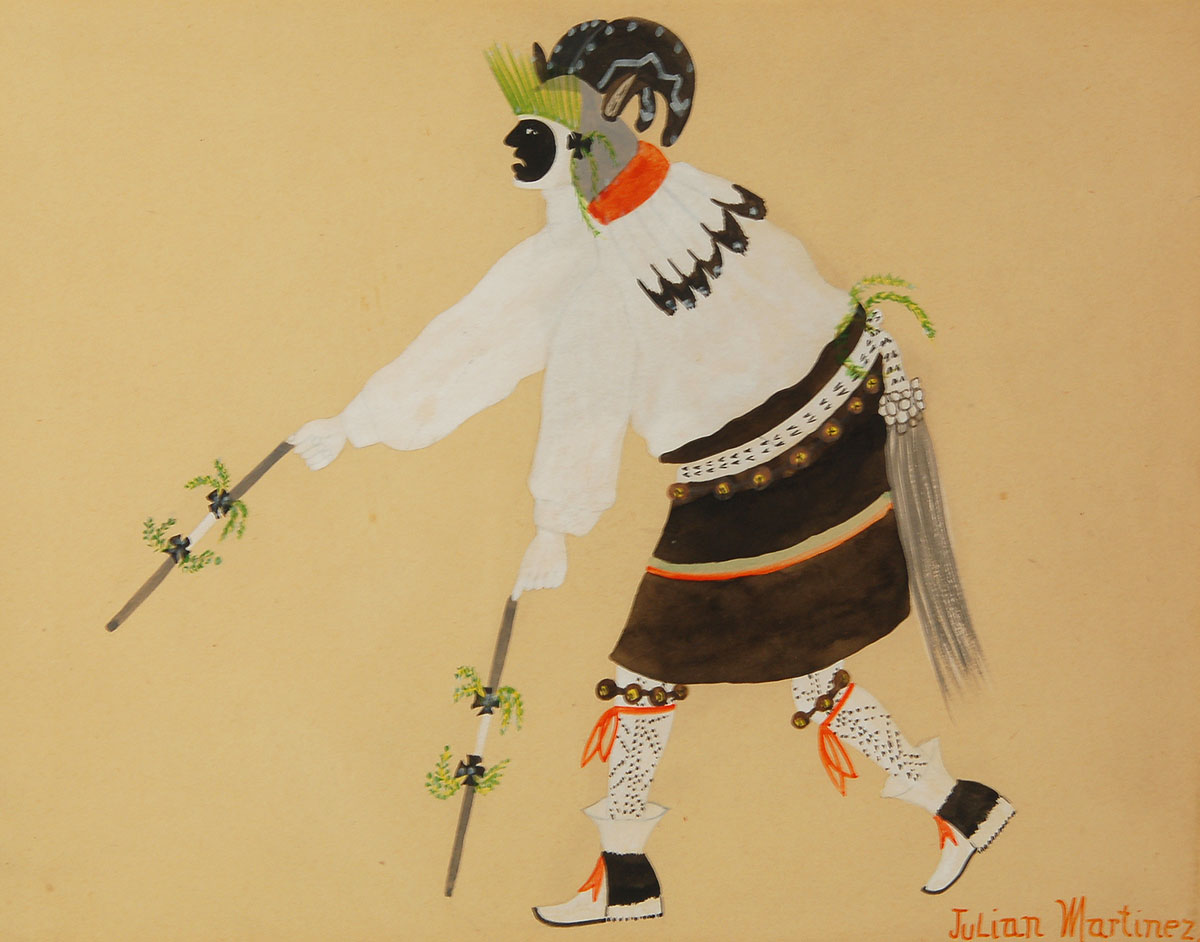 Julián Martinez (1885-1943) Pocano - Coming of the Spirits is most often associated with his wife, Maria Martinez, as the painter of her ceramics from the early 1900s until his death in 1943. He did, however, execute paintings on paper as well. He was one of the very early San Ildefonso self-taught easel artists. His watercolor paintings were a minor activity as compared to his brilliant achievements as the decorator of Maria's pottery. He was painting watercolors before 1920 and continued as time permitted until his death.
Julián Martinez (1885-1943) Pocano - Coming of the Spirits is most often associated with his wife, Maria Martinez, as the painter of her ceramics from the early 1900s until his death in 1943. He did, however, execute paintings on paper as well. He was one of the very early San Ildefonso self-taught easel artists. His watercolor paintings were a minor activity as compared to his brilliant achievements as the decorator of Maria's pottery. He was painting watercolors before 1920 and continued as time permitted until his death.
Traditional Zia Pueblo Polychrome Olla by Sofia Pino Medina - C3841A
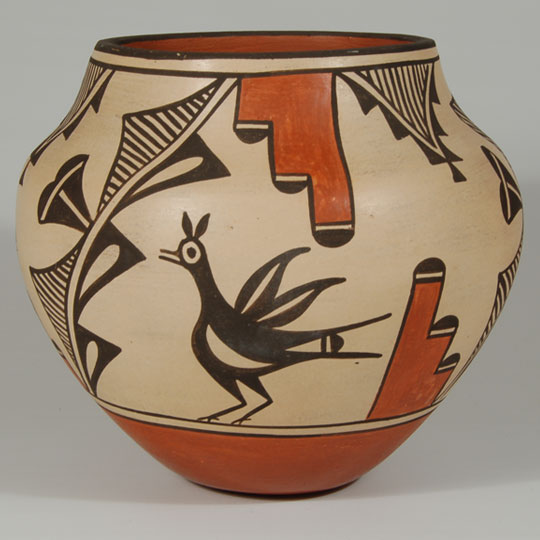 Sofia Medina is certainly one of the best known of her generation of potters from Zia Pueblo. She married into the Medina family in 1948. She and her new husband Rafael (1929-1998) lived with his grandmother, Trinidad Medina who taught Sofia the techniques of potting. Her mentor, Trinidad, was one of the most talented potters at Zia and Sofia learned well and produced quality wares throughout her life. Sofia used all natural materials in her pottery, including the pigments for painting. Her husband is known for using acrylic paints on pottery after firing.
Sofia Medina is certainly one of the best known of her generation of potters from Zia Pueblo. She married into the Medina family in 1948. She and her new husband Rafael (1929-1998) lived with his grandmother, Trinidad Medina who taught Sofia the techniques of potting. Her mentor, Trinidad, was one of the most talented potters at Zia and Sofia learned well and produced quality wares throughout her life. Sofia used all natural materials in her pottery, including the pigments for painting. Her husband is known for using acrylic paints on pottery after firing.
Original Painting of a Peyote Theme “The Survivor” by Al Momaday - C3834E
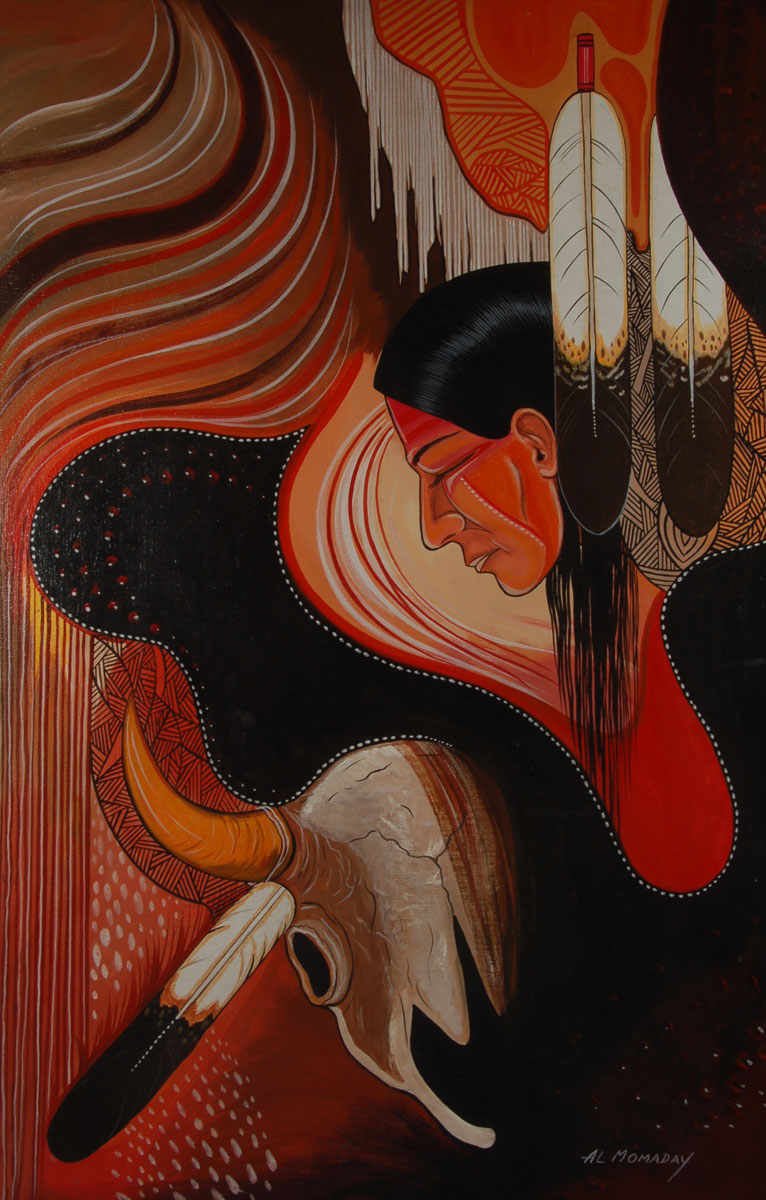 Alfred Momaday (1913 - 1981) Haun Toa - War Lance is as well-known as a teacher and educator as he is an artist. He was of the Kiowa Tribe but spent 20 years as a principal and teacher at the Jemez Pueblo Day School. He lived in New Mexico from 1947 until he passed away at Jemez Springs in 1981. He was the son of A-ho and Mammedaty - Standing High and the father of Pulitzer Prize-winning author, N. Scott Momaday. He was married to author and poet Natachee Scott Momaday who was of Kiowa and Cherokee heritage.
Alfred Momaday (1913 - 1981) Haun Toa - War Lance is as well-known as a teacher and educator as he is an artist. He was of the Kiowa Tribe but spent 20 years as a principal and teacher at the Jemez Pueblo Day School. He lived in New Mexico from 1947 until he passed away at Jemez Springs in 1981. He was the son of A-ho and Mammedaty - Standing High and the father of Pulitzer Prize-winning author, N. Scott Momaday. He was married to author and poet Natachee Scott Momaday who was of Kiowa and Cherokee heritage.
Hopi Jar Inspired by Works of Nampeyo by Mark Tahbo - 25682
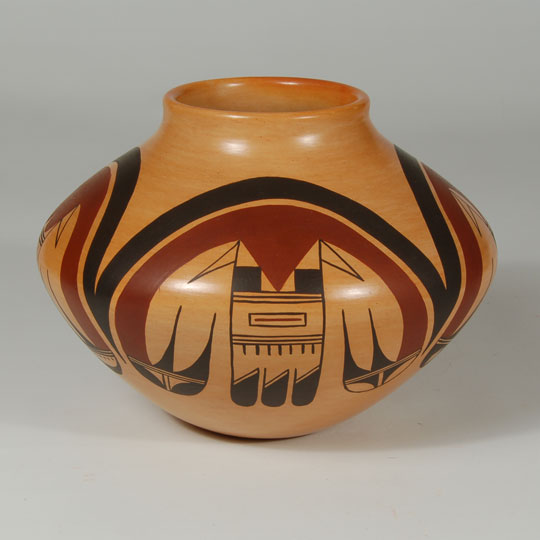 Mark Tahbo has long been inspired by the works of Grace Chapella, his great-grandmother. Grace was fond of using images of butterflies or moths on her pottery, to the point that it became her signature design. Mark followed her style for many years. Recently, however, he has become enchanted with the work of Nampeyo and has begun incorporating her style into his pottery designs, although not copying anything but using them for inspiration.
Mark Tahbo has long been inspired by the works of Grace Chapella, his great-grandmother. Grace was fond of using images of butterflies or moths on her pottery, to the point that it became her signature design. Mark followed her style for many years. Recently, however, he has become enchanted with the work of Nampeyo and has begun incorporating her style into his pottery designs, although not copying anything but using them for inspiration.
Acoma Pueblo Heartline Deer Jar by Emma Lewis Mitchell - C3658C
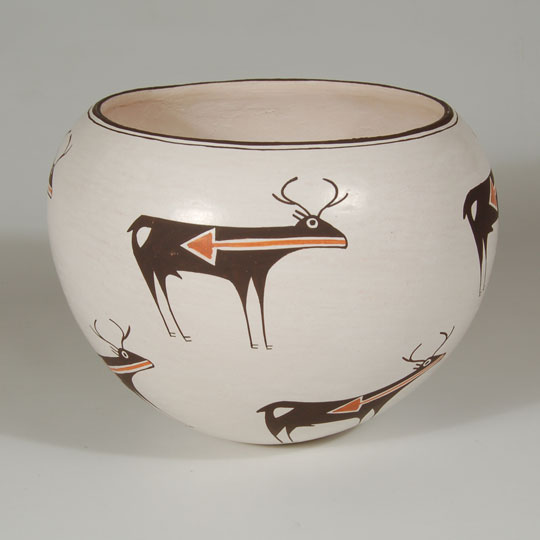 Emma Lewis Mitchell was a daughter of Lucy Lewis and her siblings were Ann Lewis Hansen, Mary Lewis Garcia, Dolores Lewis Garcia and Carmel Lewis Haskaya, all of whom are outstanding potters.
Emma Lewis Mitchell was a daughter of Lucy Lewis and her siblings were Ann Lewis Hansen, Mary Lewis Garcia, Dolores Lewis Garcia and Carmel Lewis Haskaya, all of whom are outstanding potters.
This jar by Emma Lewis Mitchell is typical of her fine quality work. It was well formed and sanded. The white slip covers the entire outer surface, including the underside, and reveals the hands of a potter who was an expert at polishing the surface. The white slip is smooth and highly burnished. There are eight heartline deer over the body of the vessel. Each was painted to perfection.
Hopi Chof - Antelope Katsina Doll by Otto Pentewa - 25908
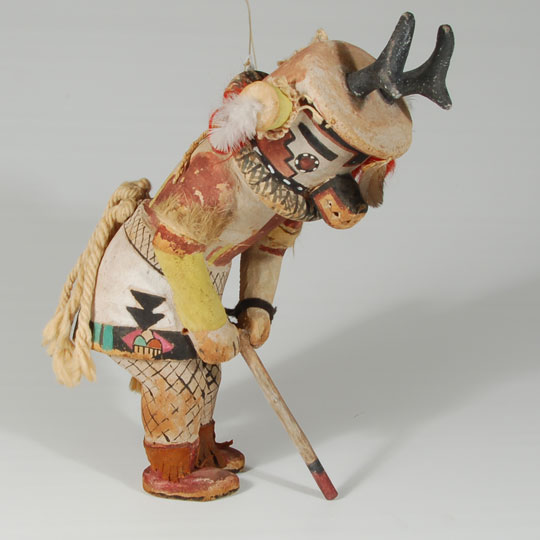 This carving pre-dates the advent of acrylic paints in the 1960s. It appears to date from the period of pre-World War II, probably the 1930s. The doll stands firmly without use of support.
This carving pre-dates the advent of acrylic paints in the 1960s. It appears to date from the period of pre-World War II, probably the 1930s. The doll stands firmly without use of support.
Otto Pentewa (1886-1961) and Wilson Tawaquaptewa (1873-1960) were the first Hopi katsina doll carvers to have dolls attributed to them by name. Both carvers became famous in the 1920s-1930s and each had a very distinctive style. Collectors, with little difficulty, can identify the unsigned carvings of these two individuals.
Historic Hopi Pueblo Monochromatic Large Seed Jar - C3838G
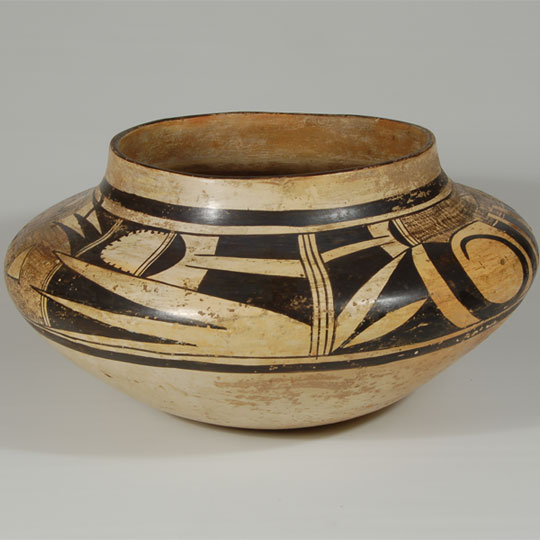 When one sees stippling on a Hopi seed jar as well as a long graceful bird beak, the temptation is to attribute it to Nampeyo of Hano, but more needs to be considered that those attributes. The vessel shape of this jar could be associated with Nampeyo but the upturned rim is not typical of her style. It is most likely that a member of her family is responsible for this one, perhaps an early jar by Fannie Nampeyo or even one by Annie Healing.
When one sees stippling on a Hopi seed jar as well as a long graceful bird beak, the temptation is to attribute it to Nampeyo of Hano, but more needs to be considered that those attributes. The vessel shape of this jar could be associated with Nampeyo but the upturned rim is not typical of her style. It is most likely that a member of her family is responsible for this one, perhaps an early jar by Fannie Nampeyo or even one by Annie Healing.
The Pueblo Potter - A Study of Creative Imagination in Primitive Art - Book
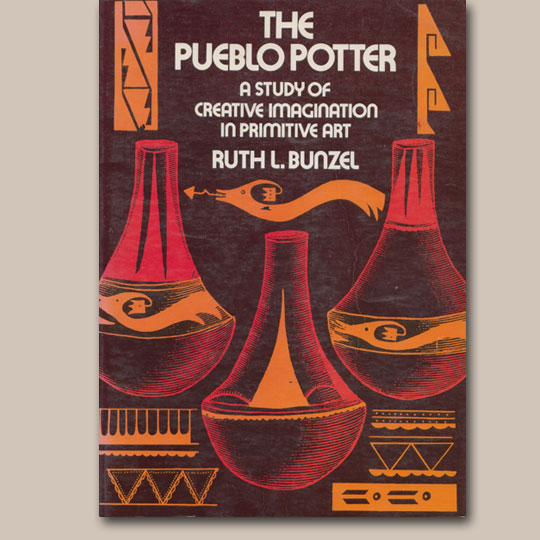 Ruth Leah Bunzel (1898 - 1990)
Ruth Leah Bunzel (1898 - 1990)
Subject: Native American Pottery
Item # 0486228754
Date Published: First published in 1929; this edition 1972
Size: Softcover, 134 pages, illustrated with drawing and photographs
How To Update My: Shipping Address

Update My:
Shipping Address
Keep us updated with any changes to your physical shipping address (if different from your regular mailing address). You can update this from the comfort of your own home at any time that is convenient to you. Just log in to your My Adobe Gallery Account and follow the prompts. Quick, fast, and easy. Always get your packages to the correct address the first time. Usually, people like to send packages to their work address or a secret address if it is a gift. Also, you might have second home and you can always keep us update on which address to use.
Note that you can also update your mailing address-if it is different. Keep informed of any shows or important information from Adobe Gallery.
We hope you'll enjoy your personal experience. Please provide any feedback for improvement. Having problems? Let us help you. send us an email describing the problem you are seeing and we'll respond: marketing@adobegallery.com
Original Painting of an Amazing Fall Landscape by Sam Smith - C3831A
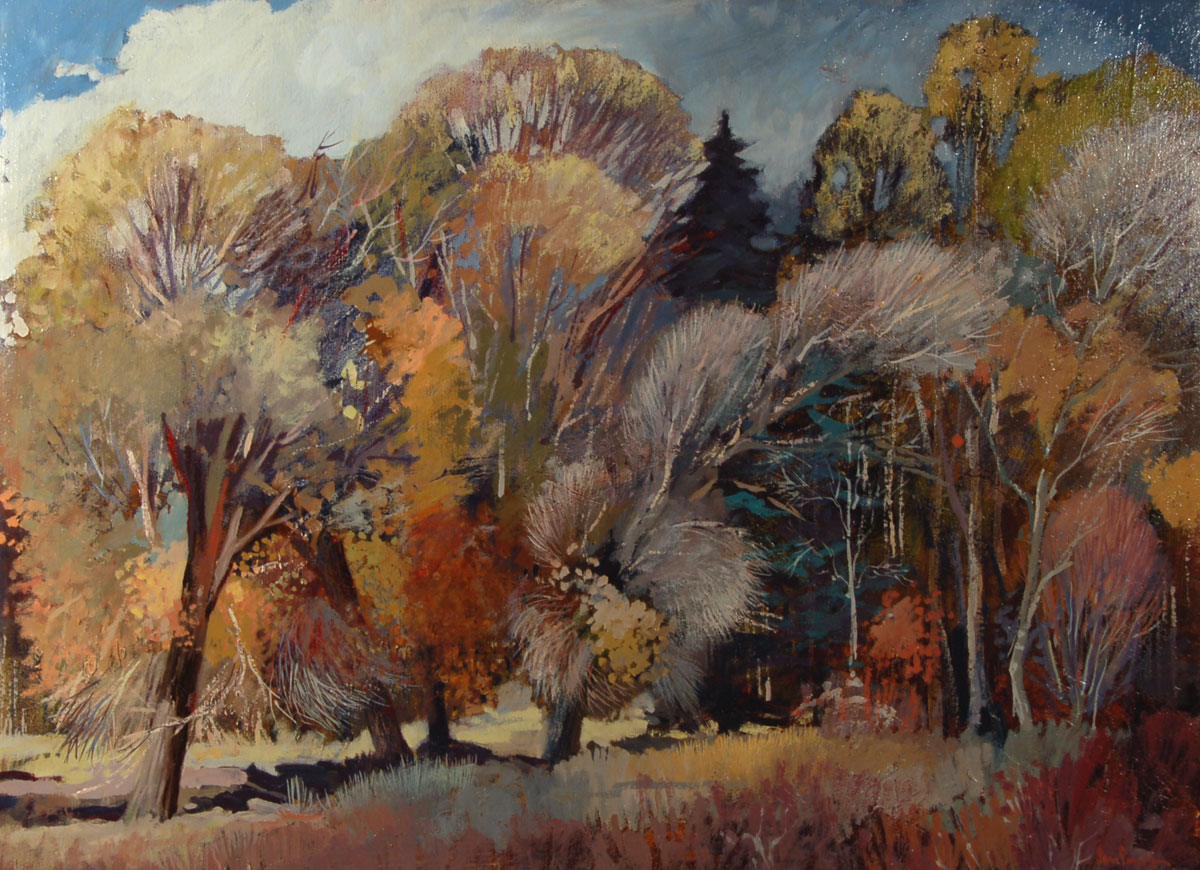 Sam Smith was one of the most accomplished Albuquerque artists during the mid-20th century. He was a friend of Wilson Hurley, who had praised his artistic accomplishments. He had moved to Albuquerque at the age of 7 years, and was associated with the University of New Mexico art department from 1956 until his retirement as a professor of art in 1984. He had studied with artists Randall Davey, Jack Levine, Ben Turner and Carl Von Hassler. During World War II, he documented combat scenes while on duty in West Africa and in the China-Burma-India Theater.
Sam Smith was one of the most accomplished Albuquerque artists during the mid-20th century. He was a friend of Wilson Hurley, who had praised his artistic accomplishments. He had moved to Albuquerque at the age of 7 years, and was associated with the University of New Mexico art department from 1956 until his retirement as a professor of art in 1984. He had studied with artists Randall Davey, Jack Levine, Ben Turner and Carl Von Hassler. During World War II, he documented combat scenes while on duty in West Africa and in the China-Burma-India Theater.
Five-piece Pottery Nacimiento from Nambe Pueblo by Marie Herrera - C3837E
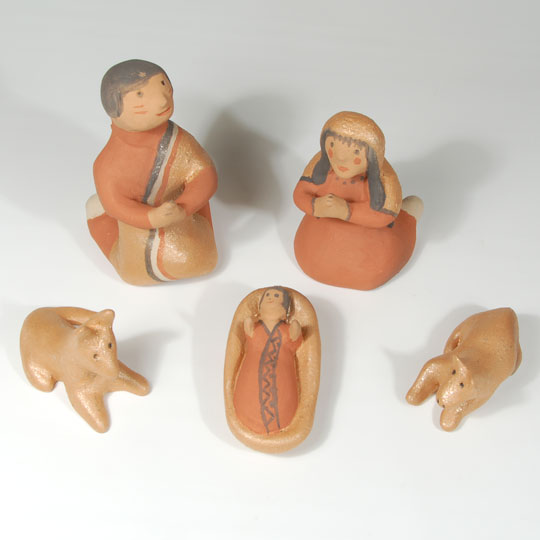 Marie Herrera is the only artisan from Nambe Pueblo credited in the book Nacimientos for making nativity sets at the time the book was published in 1979. The authors stated "Marie Herrera does different styles but is perhaps best known for her micaceous clay figures on which she uses a minimum of detailing, just a touch to delineate eyes and mouths. The figures are large and rather primitive, but the faces have great character and, as one expert notes: 'They have a very definite folk art feeling.'"
Marie Herrera is the only artisan from Nambe Pueblo credited in the book Nacimientos for making nativity sets at the time the book was published in 1979. The authors stated "Marie Herrera does different styles but is perhaps best known for her micaceous clay figures on which she uses a minimum of detailing, just a touch to delineate eyes and mouths. The figures are large and rather primitive, but the faces have great character and, as one expert notes: 'They have a very definite folk art feeling.'"
Zuni Pueblo Multiple Stone Knifewing Pin - C3837i
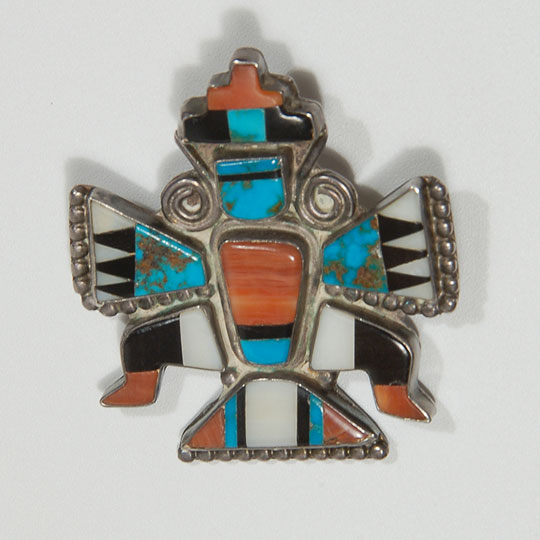 Zuni Pueblo artisans are known worldwide as phenomenal lapidary artisans and jewelry makers. They are masters at cutting stones and fitting those stone-to-stone to form mosaic imagery in jewelry. This Knifewing pin is an excellent example of the finest lapidary work from Zuni.
Zuni Pueblo artisans are known worldwide as phenomenal lapidary artisans and jewelry makers. They are masters at cutting stones and fitting those stone-to-stone to form mosaic imagery in jewelry. This Knifewing pin is an excellent example of the finest lapidary work from Zuni.
Small Black Polished Jar with Dimple Impressions by Greg Garcia - C3837C
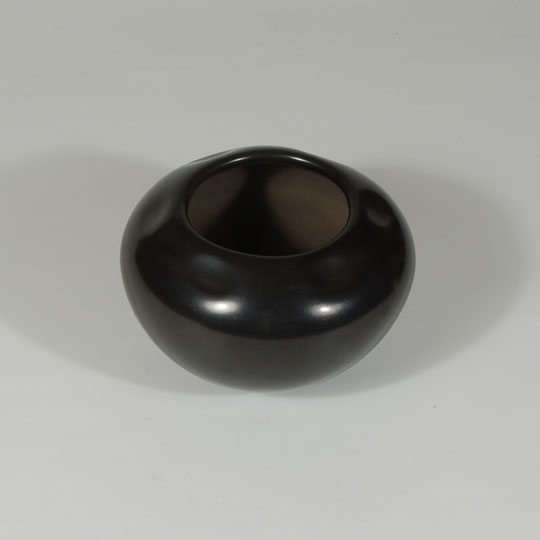 Greg Garcia claims heritage to two Tewa Pueblos of New Mexico-Santa Clara and Ohkay Owingeh. His mother was Lydia Tafoya of Santa Clara, daughter of Severa Tafoya. His father was Santiago Garcia of Ohkay Owingeh. Greg's sisters are Tina Garcia and Virginia Garcia, both of whom are well-known potters.
Greg Garcia claims heritage to two Tewa Pueblos of New Mexico-Santa Clara and Ohkay Owingeh. His mother was Lydia Tafoya of Santa Clara, daughter of Severa Tafoya. His father was Santiago Garcia of Ohkay Owingeh. Greg's sisters are Tina Garcia and Virginia Garcia, both of whom are well-known potters.
Greg was inspired to become a potter by his grandmother, Severa Tafoya, who was the mother of five female potters of distinction. He started working with the clay when he was only 14 years old. He was taught to follow all traditional methods of pottery production-gathering and cleaning clay, processing clay and building with coils, stone polishing and outdoor firing. He faithfully follows those traditions.
Zuni Pueblo Multi-Stone Rainbow Man Pin - C3837H
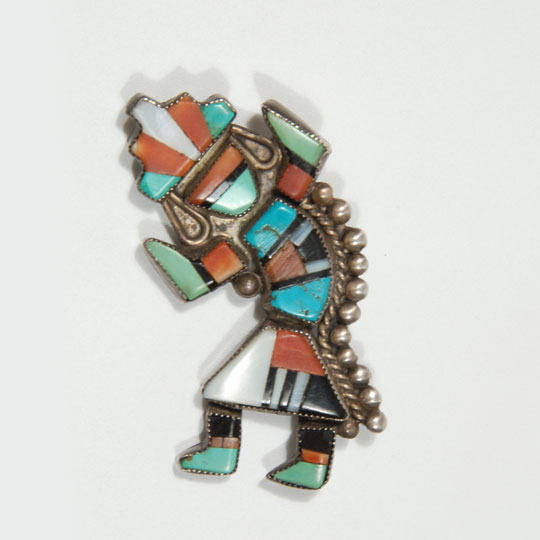 The Zuni Rainbow Man is among the most popular jewelry item for collectors. Representation of specific native religious imagery such as this was frowned upon among most pueblos, but some ceremonially significant figures were conventionalized and used for decorative purposes, probably knowingly so, because of non-Indian interest. Some of these figures had their appearances deliberately altered to avoid offending traditionalists' spiritual sensitivities.
The Zuni Rainbow Man is among the most popular jewelry item for collectors. Representation of specific native religious imagery such as this was frowned upon among most pueblos, but some ceremonially significant figures were conventionalized and used for decorative purposes, probably knowingly so, because of non-Indian interest. Some of these figures had their appearances deliberately altered to avoid offending traditionalists' spiritual sensitivities.
This Rainbow Man pin dates to the 1930s. It consists of blue and green turquoise, jet, mother of pearl, and spiny oyster shell set in stone-to-stone fashion in finely serrated bezels. Such fine bezel work is the work of an exceptionally talented jeweler. Exquisitely detailed silver rope and dots were executed for the feathers at the figure's back.
Zuni Pueblo Five Strand Coral Fetish Necklace - C3833B
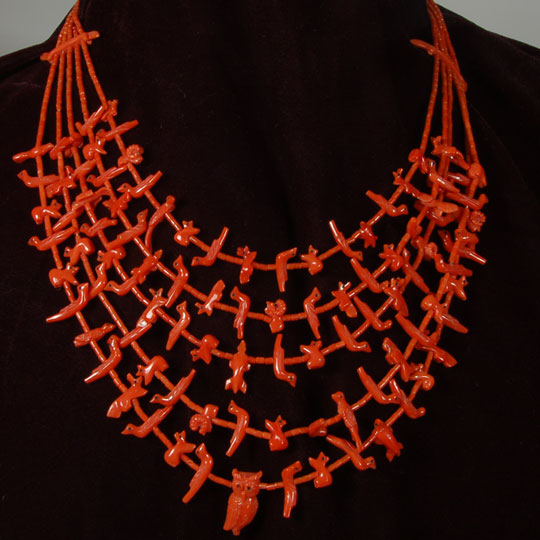 This exquisite Zuni Pueblo necklace of coral hieshe and coral fetishes contains 101 fetishes. There are rams, bears, turtles, foxes, parrots and other birds and one large owl at the bottom. The strands are graduated in a manner to allow them to display as individual strands not grouped together as a bunch.
This exquisite Zuni Pueblo necklace of coral hieshe and coral fetishes contains 101 fetishes. There are rams, bears, turtles, foxes, parrots and other birds and one large owl at the bottom. The strands are graduated in a manner to allow them to display as individual strands not grouped together as a bunch.
Cochiti Pueblo Pottery Owl Figurine by Josephine Arquero - C3837F
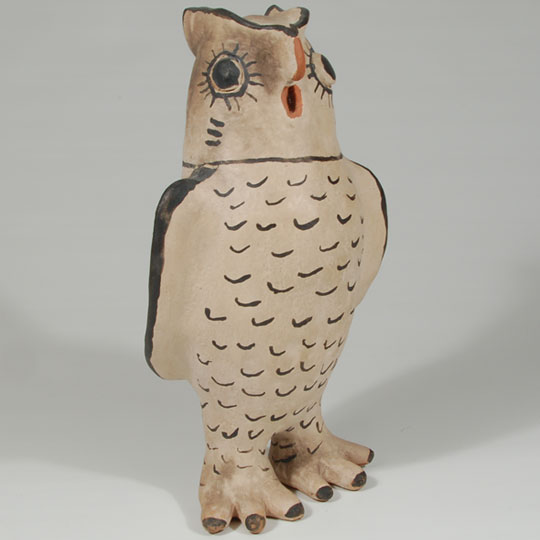 Josephine Arquero is a daughter of Damacia Cordero and sister to Martha Arquero, Marie Laweka and Gloria Herrera, all of whom are recognized potters. Josephine specializes in figurative pottery-mostly storytellers, nacimientos, and animals.
Josephine Arquero is a daughter of Damacia Cordero and sister to Martha Arquero, Marie Laweka and Gloria Herrera, all of whom are recognized potters. Josephine specializes in figurative pottery-mostly storytellers, nacimientos, and animals.
This pottery owl figurine is signed with the artist's name but not dated, however, it was purchased in the 1990s from the artist at her booth in Indian Market by the current owners. The figurine stands solidly unaided but it is provided with a metal stand for more secure display.
Mineral Earth Painting of a Pueblo Eagle Dancer by Pablita Velarde - C3565E
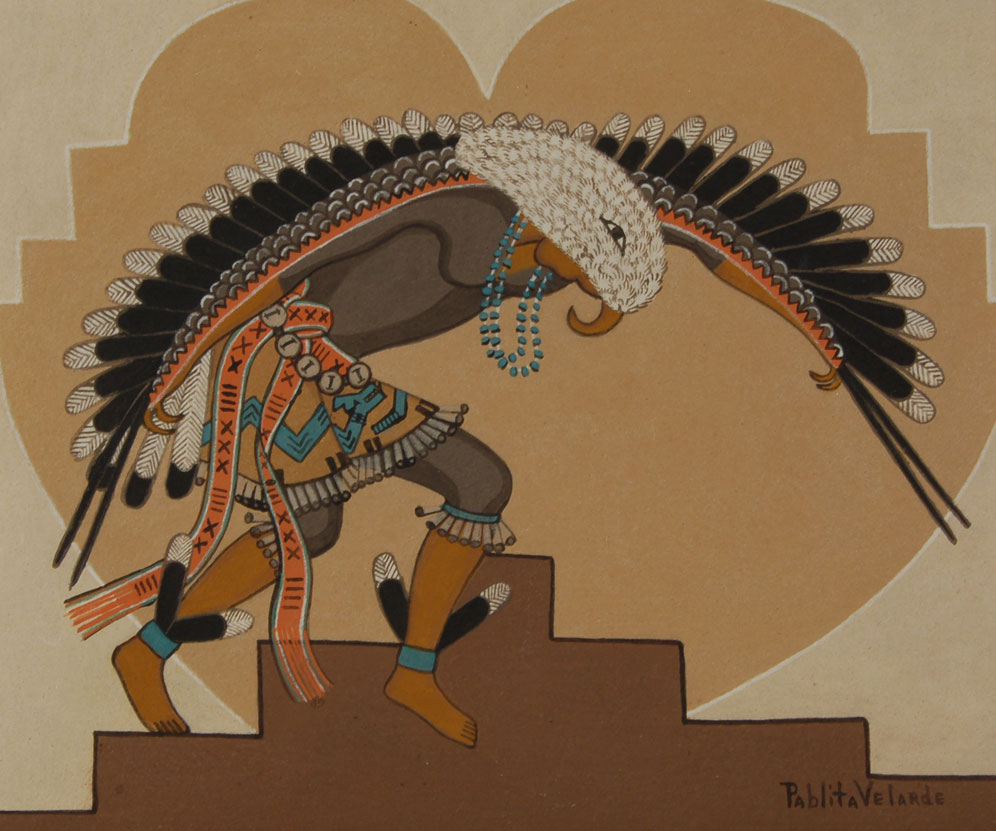 Pablita Velarde (1918-2006) Tse Tsan - Golden Dawn, Santa Clara Pueblo, was well familiar with dance costume details and she was careful to portray dancers with accurate clothing. Her paintings are ethnographically important as well as artistically important. She has provided us with a detailed representation of pueblo dancers of her time. This presentation of a very active Eagle Dancer is no exception. His costume is accurate and the presentation of the dance is as one would see at the pueblo.
Pablita Velarde (1918-2006) Tse Tsan - Golden Dawn, Santa Clara Pueblo, was well familiar with dance costume details and she was careful to portray dancers with accurate clothing. Her paintings are ethnographically important as well as artistically important. She has provided us with a detailed representation of pueblo dancers of her time. This presentation of a very active Eagle Dancer is no exception. His costume is accurate and the presentation of the dance is as one would see at the pueblo.
Hopi-Tewa Polychrome Seed Jar by Nampeyo of Hano - C3456B
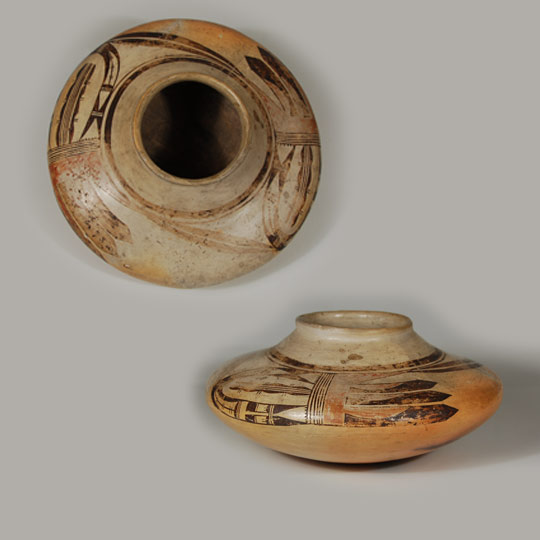 This visually charming turn-of-the-century Hopi-Tewa jar demonstrates in style and technique all the hallmarks of Nampeyo's genius. The shape is derived from the bulbous shouldered saucer-shaped jars common to the prehistoric Sikyatki pottery tradition of the 15th and 16th centuries. Nampeyo favored, as illustrated in this vessel, a conical up-thrusting neck gracefully projecting from the jar's body without seam or flexure.
This visually charming turn-of-the-century Hopi-Tewa jar demonstrates in style and technique all the hallmarks of Nampeyo's genius. The shape is derived from the bulbous shouldered saucer-shaped jars common to the prehistoric Sikyatki pottery tradition of the 15th and 16th centuries. Nampeyo favored, as illustrated in this vessel, a conical up-thrusting neck gracefully projecting from the jar's body without seam or flexure.
The design composition is perfectly complementary to the sculptural form of the vessel. The heavy unbroken black encircling upper body band separates the neck of the jar from its mid body. A single framing line just below the wide upper body band sets the parameter for laying out the design. The combination of avian designs and geometric elements points to the aesthetic of the designs of Nampeyo from 1900 through 1910.
Hopi Pueblo Avachhoya (Corn) Katsina Doll by Brian Honyouti - C3627A
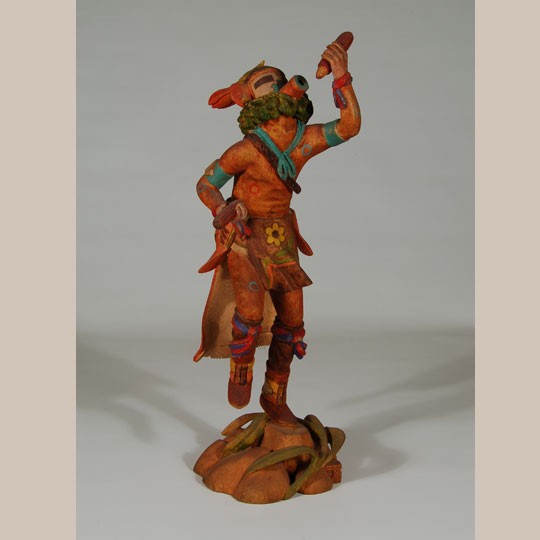 When I was actively purchasing katsina dolls from the Honyouti brothers in the 1980s and 1990s, Brian Honyouti was seriously involved in running a school for the children of his village of Bacavi. He founded the school, was the teacher, and was the principal. He funded the school from funds received from the sale of his carvings. He was a strong advocate of education. He, himself, had obtained a bachelor's degree in anthropology from the University of Arizona in 1971.
When I was actively purchasing katsina dolls from the Honyouti brothers in the 1980s and 1990s, Brian Honyouti was seriously involved in running a school for the children of his village of Bacavi. He founded the school, was the teacher, and was the principal. He funded the school from funds received from the sale of his carvings. He was a strong advocate of education. He, himself, had obtained a bachelor's degree in anthropology from the University of Arizona in 1971.
Cochiti Pueblo 8 Piece Pottery Nacimiento by Snowflake Flower - C3837D
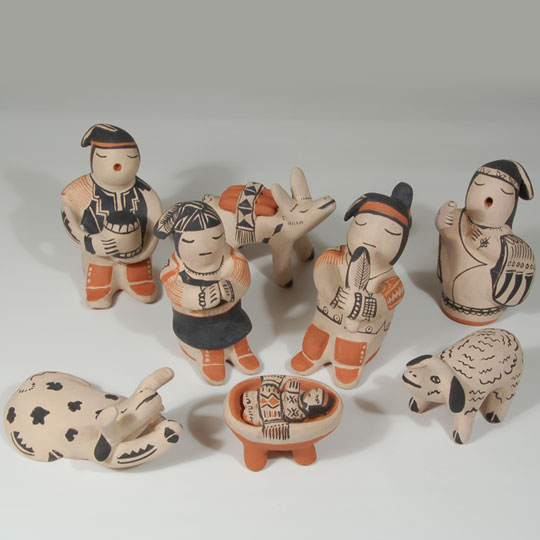 Snowflake Flower was named Estephanita after her grandmother, Estephanita Herrera, but she is known as Stephanie or Snowflake Flower. She is a sister to Ada Suina. She attended the University of New Mexico and received her BS in Education in 1985. She started making pottery figurines around 1979 and has specialized in storytellers, nacimientos, owls and other figurines.
Snowflake Flower was named Estephanita after her grandmother, Estephanita Herrera, but she is known as Stephanie or Snowflake Flower. She is a sister to Ada Suina. She attended the University of New Mexico and received her BS in Education in 1985. She started making pottery figurines around 1979 and has specialized in storytellers, nacimientos, owls and other figurines.

